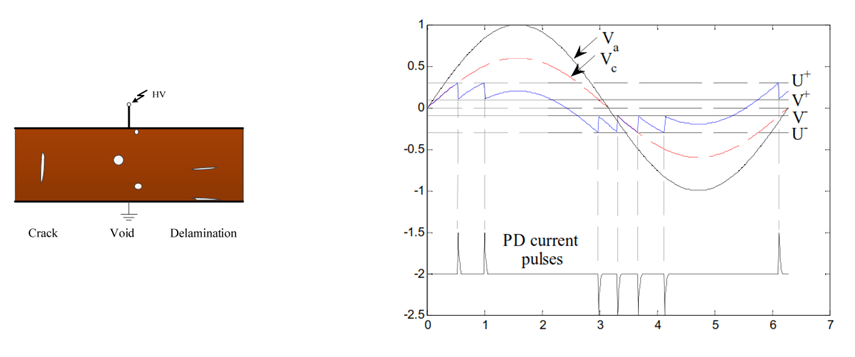A partial discharge (PD) is an electrical breakage phenomenon that is located in an insulating medium between two conductors that are at different potential. Partial discharges occur due to the existence of a non-uniform high electric field and have the effect of deterioration over time of the insulation system, that is to say reducing its useful life (dielectric stiffness breakdown).
Partial discharge is caused by dielectric stress caused by the presence of a high and non-homogeneous voltage in the insulation materials. The main causes of PD are the following:
- Non-homogeneous distribution of the electric field.
- Presence of bubbles in solid and liquid insulation.
- Punctual effects that localize dielectric stress on insulation.
- Presence of moisture, cracks or water pockets.
- Presence of contaminants in the insulation surface.
- Voltage exceeding the dielectric strength of insulating materials.
The great advantage of the PD test is that it allows us to analyze and diagnose the equipment during normal operation, since a drop in PD intensity occurs just before the failure. Once the problem is detected (see our article about the Detection methods of partial discharges), a stop will be programmed to perform the corrective action.

The partial discharges are included in 4 main groups:
Internal
The internal discharges are usually due to cavities within the electrical insulation. The cavities are weak points inside the insulator and are normally produced by bad manufacturing or due to aging of the material. The electric field within a cavity is equal to or greater than the electric field surrounding the insulation. This is because the gas has a lower dielectric strength than the surrounding insulation and as a result, the cavities are weak points within the insulation, where the PD activity begins.
The following figure shows how the PD emits pulses in relation to the applied voltage. In this figure Vc is the voltage in the cavity which is a fraction of the applied voltage Va. When the voltage in the cavity reaches U+, which is the gas breaking voltage within the cavity, discharge occurs and the voltage in the cavity drops to V+ where discharge stops.
We must bear in mind that humidity and environmental pollutant can form layers on the insulation. This unwanted layer is a path to leakage current on the surface of the insulator. This current will produce heat on the surface and generate evaporation that will cause physical disruption to the polluting layer.
Large potential differences are generated over gaps in the contaminant layer and small sparks can close these gaps. The heat of sparks causes the insulation to carbonize and leads to the formation of permanent carbon tracks on the surface.
Under such conditions, this process will develop over time and eventually lead to a disruptive discharge and complete insulation failure.
Superficial
We must bear in mind that humidity and environmental pollutant can form layers on the insulation. This unwanted layer is a path to leakage current on the surface of the insulator. This current will produce heat on the surface and generate evaporation that will cause physical disruption to the polluting layer.
Large potential differences are generated over gaps in the contaminant layer and small sparks can close these gaps. The heat of sparks causes the insulation to carbonize and leads to the formation of permanent carbon tracks on the surface.
Under such conditions, this process will develop over time and eventually lead to a disruptive discharge and complete insulation failure.

Corona
The corona is a type of discharge that occurs around acute high-voltage conduction points when the voltage gradient exceeds a critical value. The corona effect is produced by the ionization of the medium surrounding a conductor, it can also occur at a marked point at the ground potential, it can also be visible in the form of light, typically a purple glow, since the corona usually consists of microarches.
The Corona effect is a low energy process but, over an extended period of time, can substantially degrade the insulation, causing faults due to dielectric rupture. In other words, the presence of corona effect can reduce the reliability of an insulation system. In addition, it should be noted that the krona effects are cumulative and permanent, and failure may occur without warning.
The corona effect can generate:
- Light
- Ultraviolet radiation
- Sound (whistling, cracking caused by the expansion of visible gases)
- Ozone
- Nitric and other acids
- Salts (sometimes seen as white powder deposits)
- Mechanical erosion of surfaces by ion bombardment
- Heating (usually light and especially in insulating material)
- Carbon deposits, creating a potential arc path
In the case of electrical switchgear, if the enclosed equipment is not well ventilated, ionisation can reduce the dielectric resistance of the air and the shorter insulation distance will eventually cause a high-energy electric arc from phase to phase or from phase to ground. The accumulation of nitric acid within an enclosed space such as the air-insulated distribution board will create carbon footprints on insulating materials. Ion bombardment also destroys some solid insulation materials, eventuallyconverting them to dust. 
Electrical treeing
Electrical treeing originates from a defective point such as a small gas vacuum, a sharp electrode edge or a metallic particle, where the electric field is high. This partial discharge can generate ozone and ultraviolet light and eventually react with the surrounding dielectric material and cause decomposition resulting in a new vacuum. This weak spot can grow and grow over time forming a tree within the insulation. This tree can grow to the point that it causes a complete break.

For more information, see the section partial discharge detectors
Related articles: